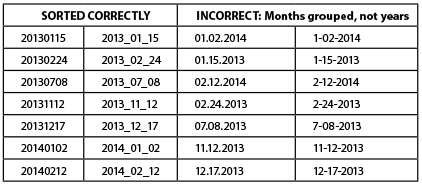Subscriber Benefit
As a subscriber you can listen to articles at work, in the car, or while you work out. Subscribe Now
 How important can a file name really be? Most of us probably assume the contents of the file are far more important than what we name it and do not realize that improper file names can make it both harder on us and our computer to find and open the file again in the future.
How important can a file name really be? Most of us probably assume the contents of the file are far more important than what we name it and do not realize that improper file names can make it both harder on us and our computer to find and open the file again in the future.
Understanding file naming
One of the biggest factors in understanding why proper file naming is important is to understand how file names work in most operating systems. There are three main parts to a full file name: the path, the name and the extension. Each of these parts works together to tell the computer where the file is located and which program should be used to open the file.

The path tells the computer where the file is located, the name identifies which specific file in that folder to open, and the extension dictates which program the computer should use to open the file. Special characters are used within the file name to help the computer distinguish between the path, the name and the extension. In the above example, the “:” designates the file is located on the P drive, each “” indicates a new folder level that the computer should navigate to find the specified file, while a “.” specifies the file extension will be the remaining characters listed. As you can imagine, when these characters are used out of context, it can cause confusion and potential issues for the computer attempting to open the file.
Limitations
There are standard best practices recommended across platforms (including both Windows and Mac). It is important to note that disregarding these requires the computer to work harder to decipher, ultimately impacting performance and potentially resulting in the inability to open, modify or save the file.
Invalid characters. There are several reserved characters that should never be used in any portion of a file name, as most programs will not even allow files to be saved with these characters in the name:
< > : “ / | ? *
While periods are technically allowed in file and folder names, it is not a good idea. As mentioned above, their purpose is to separate the name from the extension so when a period is used outside of that context it can cause slowness as the computer attempts to determine where the extension is, and in some programs, including a couple of well-known litigation databases, will cause errors.
Length. Both Windows and Mac have limitations on the length of the file names. Neither will allow file names to be saved that exceed the character limit, but once the file is saved, it can be renamed to exceed the limit and will eliminate the ability to open the file without first renaming or copying it to another location that is within the character limit. The total number of characters across all three pieces of the file name can be no longer than 255 characters.
Standardizing abbreviations
Given the restriction on the total number of characters in both folder and file names, it is recommended that firm-wide standard abbreviations be used within all folder and file names. Consistency allows for easier location in the future when searching and sorting. These abbreviations should be documented for reference by all. Some examples are below.
LTR = Letter | CORR = Correspondence | EML = Email | MRR = Medical Records Request
Working with dates
Dates are great additions to folder and file names for purposes of noting when something was last updated or received. Unfortunately, if standards are not implemented within a firm, they can be difficult to sift through as they may not sort properly or may be located in different parts of the file name, not allowing for sorting by that date. It is recommended that dates be formatted in the international standard format of YYYYMMDD and be placed at the beginning of the name to allow for proper sorting. If you need a separator, an underscore is recommended in lieu of a period and should be used consistently by everyone to allow for appropriate sorting. The table below exemplifies the issue with other formats.

While these practices may seem over the top or a pain to enforce, they will be far less painful than running into an issue in the future preventing anyone from being able to access a specific file because of a file naming violation.•
Deanna Marquez ([email protected]) is a co-owner of the Indianapolis-based legal technology company Modern Information Solutions LLC. Areas of service include traditional IT services, software training, and litigation support including trial presentation services. The opinions expressed are those of the author.
Please enable JavaScript to view this content.
